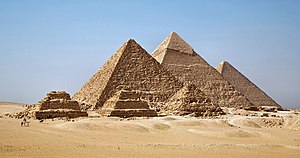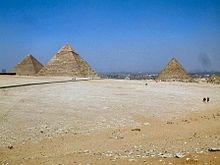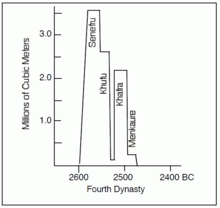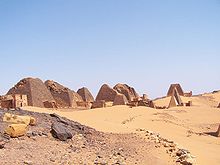Pyramid (building)
The pyramid (from ancient Greek πυραμίς pyramis [ Gen. πυραμίδος pyramidos ] from Egyptian pꜣmr , tomb, pyramid ') is a design, usually with a square base, which is known from different ancient cultures, such as Egypt , Latin America , China and the Canaries (see Pyramids of Güímar ). Pyramids were mainly built as buildings with a religious ( death cult ) and / or ceremonial character.
Origins
Step pyramids or pyramid-like structures were built in ancient times at different times on different continents . Today researchers assume that there were no connections between the different cultures, separated by great geographical distances, but that tribes living far apart built these structures completely independently. There are different theories about the origin of this construction:
In the field of Egyptology , with regard to the original idea of building the pyramids, the theory has been developed that especially the shape of the step pyramid should represent the ancient Egyptian social structure with its hierarchy .
According to an Egyptological theory, pyramids only represent a consistent architectural and structural development, in Egypt starting from rectangular burial mounds made of sand in prehistoric times, later with mastabas and subsequently step pyramids as intermediate stages. For other cultures, a cult mound can be assumed as the starting point for such a development instead of a burial mound. Both theories can be applied beyond Egypt to all other cultures that also built pyramids or pyramid-like structures.
Egyptian pyramids
The tombs of many Egyptian regents (pharaohs) of the Old Kingdom (approx. 2680 to 2180 BC) and parts of their court are pyramids. These pharaohs are therefore also called pyramid builders.
The development of the ancient Egyptian pyramids began with so-called mastabas ; initially a single-tier, flat building made of adobe bricks , on which further steps were later added. As a result, the step pyramids emerged in the 3rd dynasty . However, only Djoser's step pyramid in Saqqara was completed, while two other step pyramids (the Sechemchet pyramid and that of the Chaba ) of this dynasty remained unfinished.
In the 4th Dynasty , Pharaoh Sneferu presented three huge, mature pyramids ( Meidum pyramids , kink and red pyramids in Daschur) relatively quickly, in just a few years , which, together with the three pyramids of Giza, made about 3/4 of the total mass make up Egyptian pyramids, and this already within the first 100 years of the approximately 2700 year pyramid period. Even if the construction of the pyramids was very different, they are all based on the same basic concept with an inner step pyramid , which consists of inwardly inclined buttress walls, and, if necessary, a smooth jacket placed on top.
The complexity of the pyramids, their artistic design, their angles of inclination , and the design of the burial chambers vary greatly across the dynasties.
There are different theories as to how the Egyptians chose the angle of slope of their pyramids. One assumes that the Egyptian cubit with 28 fingers was always chosen for the vertical line of the gradient triangle of the pyramid , while the length of the horizontal line has a variable number of fingers. The kink pyramid has two different slope angles (28:20 and 28:30). Pharaoh Sneferu set the slope angle 28:22 (51 ° 50 ′) for his Meidum pyramid . This angle was adopted by Pharaoh Cheops . In the 5th dynasty, Pharaoh Niuserre continued this construction method with his pyramid in Abusir.
In total there are about 80 known pyramids in Egypt. The largest is the Great Pyramid at Giza . It has a footprint of around 230 × 230 meters and was around 146.60 m high after its completion. Its current height is only 138.75 m. Are located in the immediate vicinity of Chephren - and the Mycerinus pyramid as well as smaller, so-called by-pyramids. The Chephren pyramid is about 3 m lower in its original height (143.5 m), but appears larger than the Cheops pyramid because it was built on a 10 m higher rocky ground. With a height of 65.5 m, the Mykerinos pyramid is clearly differentiated from the other two, it is not even half as high as it. All the pyramids of the Giza Plateau were built during the 4th Dynasty (approx. 2630-2525 BC).
After the largest pyramids, which were built in the Old Kingdom (up to approx. 2200 BC), those of the Middle Kingdom (main building activity approx. 1975–1750 BC) were smaller, and other grave structures became smaller elected. In the second interim period , numerous rulers began building a pyramid, but almost none was completed. The last Egyptian king to have a pyramid completed was Ahmose I , who around 1550 BC. Founded the 18th dynasty. Its Ahmose pyramid , the only one in the New Kingdom , had a core of rubble and has therefore crumbled today. After that, only in the kingdom of Kush from approx. New pyramids were built.
Importance of the pyramid
The pyramids served as burial places for the pharaohs in ancient Egypt. The walls inside these structures were undecorated up to and including the 4th Dynasty. The so-called pyramid texts have been found in the burial chambers since the 5th dynasty . The way to the tombs led through a long tunnel in the pyramids. To protect against grave robbers , the entrance to this tunnel was hidden and carefully barred. The pyramids were built near the Nile so that the stone blocks could be transported there by water. The last part was pulled on sledges.
The approximately 60-meter-high step pyramid of the Djoser (Old Kingdom) was expanded five times during its construction. The first building was a massive stone building 63 meters in length and 8 meters in height, the shape of which corresponds to the mastaba of high court officials at that time . The outer surfaces of this structure were made of fine Tura limestone and had already been carefully processed and smoothed before the first extension was built over it. The first extension increased the structure by 3 meters on all sides. In a second step, eleven shafts were created on the east side, which reach 33 meters deep into the rock bed. Then the mastaba was extended by eight and a half meters so that it covers the shafts. In one of the tunnels that branch off from these shafts, numerous vessels from earlier dynasties were found, which were apparently brought here from other grave-robbers-haunted tombs during Djoser's time. Before this third expansion stage was completed, the fourth phase of the renovation began. Now the side of the building has again been extended by three meters, but at the same time it has been given the shape of a step pyramid 40 meters high for the first time. In the last expansion stage, the pyramid was finally expanded on the north and west side to a total area of 125 x 110 meters and the height was increased to 60 meters by two additional steps.
A mythological interpretation of the step pyramid is that through the construction of the step pyramid a huge stone staircase to heaven should be realized, which should enable the deceased king to take on an equal rank as the sun itself as the "human equivalent of the sun ( Horus )". The pyramid thus allowed the king to achieve immortality in his “ house of eternity ”.
Architecturally, the shape of the step pyramid is an impressive and well thought-out enlargement of the original mastaba. The last expansion alone means an increase in the stone volume from 200,000 to 850,000 tons. A scaling up of the original mastaba would not only have increased the material requirements considerably, such a structure would also not be sufficiently stable. The step pyramid basically represents six masts placed one on top of the other, which correspond to the shape of the burial place customary at the time, but in its overall dimensions it forms an impressive and at its time unprecedented building.
The techniques developed in building this first pyramid form the basis of all subsequent pyramids. The inside of the “real” pyramids also consists of a step pyramid, which is clad with smoothly hewn stones. A large number of trained and experienced specialists were necessary for the construction of the pyramids, and they had to be looked after. Since the pyramids were demonstrably erected from bottom to top, on the entire planned area, the construction created a problem comparable to a pyramid system . The higher the pyramid grew, the smaller the area that could be built on and the fewer workers could be found here. If the workers did not become unemployed, construction of the next comparable structure had to be started as soon as a pyramid had reached about a third of its total height.
Procedure and building materials
Most of the texts about the construction of the pyramids are based on traditions, studies, experiments and estimates, all of which explain in a different way the possible construction techniques of the Egyptians.
On the walls of the burial chamber of the builder Senedjemib Inti , the fact is handed down to us that he designed and executed the plans for the pyramids and palace complex of King Djedkare- Isesi ( 5th dynasty ). A few generations later, the funerary inscription of the expedition leader Weni tells us that the man from the quarries of Eastern Egypt transported building materials for pyramids and temples of King Merenre ( 6th Dynasty ) to Saqqara, but without any explanation of how this happened.
The tools used to build the pyramids were made of copper , stone, and wood and weren't very complicated. The copper tools as well as chisels , saws and axes had to be continuously hardened, which was very expensive and time-consuming.
To break whole boulders of soft rock out of rock faces, hammers made of hard rock, e.g. B. Dolerite . The outer sides of the pyramids were originally clad with white limestone ( iner hedj ), which was quarried from the Mokatan rock massif near Cairo or Tura and is found in many types. For the core construction of the pyramids, however, coarse, local nummulite limestone , which was of inferior quality, was used.
From hard deep rock z. B. rose granite , which was mainly mined on the southern border near Aswan , sarcophagus chambers, cladding blocks, false doors , blocking blocks, reinforcements of the corridor, the corridor system of the interiors, pillars , columns and door structures of the temple were made.
For temple floors, sarcophagi, canopic boxes and altars , Egyptian alabaster was used, which was obtained in Wadi Geraui near Cairo and above all in Hanus (Middle Egypt) and is of particularly good quality. This is not a normal alabaster (variety of plaster), but a variety of calcite .
The very hard and black volcanic rock basalt was used for the temple floors of the Great Pyramid of Cheops .
The country of Egypt has numerous stone deposits, but the wood resources are all the more meager here, because the typical date palm , acacia , dump palm and tamarisk wood is not suitable for such large construction projects as the pyramids. Finds from tombs of the 1st Dynasty show that conifers were imported from the Syrian-Palestinian region, mainly for the manufacture of sleds, rollers, levers and hammers. The wheel was already known to the early Egyptians, but it was not used in construction.
For the construction itself, the huge blocks of stone were put on wooden rollers and pulled onto the giant building ramps by muscle power with the help of ropes made of palm fibers, grass, papyrus and flax . In order to conveniently deliver the stones to the pyramids, channels to the Nile were created.
The blueprints were painted in stone or papyrus and were based on the easiest of mathematics . The Egyptians also succeeded in calculating the volume of all conceivable three-dimensional bodies and determining their weight and size.
The Greek historian Herodotus (no contemporary witness) reports: Cheops, the evil pharaoh, forced all subjects to help build the pyramids. Ten times 10,000 men worked ten times for three months and that for 20 long years - therefore in corporal service close to slavery. Herodotus also reports of machines that were “made from short blocks of wood”, which is still speculated about today, from cranes to pulleys, all theses are represented.
Herodotus did not speak of 100,000 people, but of 10 times 10,000 men, who were deployed in a row or, more specifically, 25 years or only 20, if one estimates 5 for the construction of the infrastructure of canals, roads, settlements etc.
Construction of the Egyptian pyramids
No exact dates and construction methods have been handed down. There are different theories about the construction of the pyramids. So far, however, none of these has been fully proven. The construction of the pyramids was very different. The step pyramid is the oldest form of such monumental structures ( see also the tomb of Pharaoh Djoser ). The architect Imhotep created a building that stood out from all previous tombs due to its size and shape in order to demonstrate the uniqueness of the Pharaoh. Building on the shape of a mastaba, the steps became smaller, so that a uniform pyramid shape was created, which tapered towards the top and pointed towards the sky. With that the idea of the pyramid was born. This construction method was retained for centuries.
The pyramids of the Old and Middle Kingdoms were clad with fine limestone, but this cladding is now largely destroyed by stone robbery. Larger parts of the cladding are preserved in the bent pyramid and in the upper part of the Chephren pyramid. In addition, in the base area of most of the pyramids there are preserved cladding stones that were covered by rubble during the stone robbery and thus protected.
Surveying during construction
A pyramid stands on a precisely leveled surface, the vertical deviation of which is no greater than a few centimeters. For this purpose, the land was first leveled, then trenches were dug, which were filled with water after their completion. The water made it possible to level the base surface. In order to secure the structure against displacement, the corner stones were deepened and the foundation stones were inclined inwards by two to three degrees. The edges of the pyramid base were very precisely aligned with the four cardinal directions, for which the ancient Egyptians used star gazing. The rise and fall of a certain star was probably observed on a wall around the pyramid. The main passage to the burial chamber led into the pyramid at the same angle as the star to be leveled.
How was it now possible that the builders of the pyramid were able to maintain the exact angle of inclination up to the pyramid tip? The pyramid was built in layers, the corner stones of which were not exactly coordinated. Only with the cladding were continuous surfaces and ridges created.
Of central importance was probably the plumb line with which the center of the square pyramid floor plan was "drawn up" as construction progressed in different layers. This enabled precise control of the altitude above the starting plateau and the horizontal measurement. At half the height of the pyramid, the horizontal edge length is also half the floor plan edge length. The vertical enables the angle of inclination to be precisely observed and also allows measurements in the diagonal . The parallelism of the upper stone layers to the base can be created by aligning lines in an east-west direction as follows: In the morning and in the evening the sunlight falls horizontally. For this purpose, vertical escape poles are set up at the level of the plateau. With the sun as a fixed point, they result in a straight line. The same is laid out according to the construction progress at the respective altitude. If there is agreement between the two alignments, then the parallelism is given.
Subsequent measurement
With most pyramids, the edge lengths of the base can be measured directly, but not the height, which is not directly accessible due to the lack of complete cladding and erosion. However, by measuring the angle of inclination of the side stones obtained, an exact determination of the pyramid height is possible, even if the pyramid structure is largely destroyed. In the case of pyramids whose cladding has been completely removed or never attached, both the height and the angle of inclination can only be estimated.
Manpower
Several thousand workers were employed to build a pyramid. According to tradition, 70,000-100,000 workers helped build the Cheops pyramid in front of Gizeh, but this seems logistically impossible based on current research. On the other hand, it is fairly certain that “only” around 8,000 workers were employed in the quarries and at the pyramid.
Little is known about the legal status of workers involved in building pyramids. The majority of scientists today assume that the workers in the Old Kingdom were not slaves . For example, inscriptions were found in the graves of workers in which the pharaoh promised to provide for the workers' daily needs. Bone finds also prove that the workers received medical attention. However, on a fragment of an annal stone of the 5th dynasty , it is reported that 70 female foreigners were delivered as tribute to the pyramid of Userkaf .
On the Annal Stone of Amenemhet II it is reported that Asian prisoners were used at the ruler's pyramid. From inscriptions on the pyramid of Sesostris I , we learn that the Lower Egyptians in particular were used to build pyramids. A workers distribution office is known from the Middle Reich , which was responsible for the provision of workers and their care.
Stone transport
→ Main article: Theories of stone transport in the construction of the Egyptian pyramids
The stones for the Giza pyramid complex were brought from the nearby Mokattam Mountains . For the Cheops pyramid alone, 2.3 million stones, each weighing at least 2.5 tons, were used. Various types of stone were used to build the pyramids, e.g. B. Limestone, Granite and Sandstone . How the stones were pulled up on the growing pyramid is not yet fully understood. a. suspects that the large stone blocks were pulled up on a ramp that spiraled around the pyramid. Other ramp designs are feasible, most likely a combination of internal and external ramps. The reason for the ramp construction is primarily the transport of the stone slabs of the burial chamber, which weigh up to 50 tons. A ramp must therefore be led to a height of one third of the total height in order to reach the burial chamber. Around 80% of the stone material is installed at this height. It can be assumed that the ramp was built with the missing 20% stone material. This was gradually dismantled as the building height increased so that the ramp material could be used as a building material for the upper part of the pyramid. Ramps from sand dumps are therefore not likely. Another theory takes the use of machines into consideration: Although lifting and pulling tools for stone blocks weighing 40 tons have never been found, there have been finds from workshops and labor camps in which appropriate winches may have been made. Overall, it can be stated that many theories about pyramid construction have been refuted and none can be regarded as definitively proven.
The ramps
The monumental ramps that were necessary to transport the building material to the required height pose great puzzles. There are several theories about this too. A more recent theory by the architect Jean-Pierre Houdin assumes that the stones were transported along a tunnel inside the pyramid. This ramp then grew continuously and led upwards in a spiral form below the four outer sides. The corners of the pyramid were open and the stones could be turned there. With this assumption, the huge amounts of building material that would have been necessary with the alternative side ramps or a ramp winding around the pyramid are omitted. Archaeological evidence will be sought on site.
Nubian pyramids
→ Main article: Nubian pyramids
The function of the pyramid as a burial place was later adopted in Nubia (from around 800 BC) . The royal tombs of Meroë are particularly noteworthy here.
Mesopotamian ziggurats
→ Main article: Ziggurat
A ziggurat (in Babylonian "towering, piled up", "heavenly hill", "god mountain") is a pyramid-like step temple in Mesopotamia . About 25 such structures have been found in Babylonia . The biblical tradition of the Tower of Babel possibly goes back to such a building.
Pyramids in Latin America
According to the current state of research, the Latin American pyramids have developed, in part in accordance with the Mesopotamian buildings, from mounds of earth raised by human hands, which were supposed to protect the restful structure (house, palace, temple) from flooding during the often heavy rains. It is therefore not surprising that the first pyramids in Mesoamerica, which are attributed to the culture of the Olmecs , were built on the rainy and humid coast of the Gulf of Mexico . In the course of time, differentiations developed in the substructures for temples on the one hand and palaces on the other: While the temple pyramids became larger and higher, the lower, often broad substructures of the palaces sometimes even ended in small courtyards ( Tikal , Copán ); such a - predominantly secular - assembly on the top of a hill is referred to in American archeology as the 'acropolis'.
Mesoamerica
The stone-built Mesoamerican temple pyramids are primarily to be viewed as substructures for the temple (or temples) at the top and consecrated to the gods. It has been known since the 1950s that burials were carried out in some - but by no means all - Mesoamerican pyramids or that these buildings were erected over the graves of rulers, priest-kings, scribes and sacrificed people ( Palenque , Teotihuacán , Copán, etc.). Many of the Mesoamerican temple pyramids were built over - sometimes even several times; In this way, some older pyramids and temples have been preserved in whole or in part (Teotihuacán, Uaxactún , Chichén Itzá , Dzibilchaltún, etc.).
South America
The huge Peruvian adobe pyramids are poorly preserved - their origin is possibly in the replication of the rain- giving Andean mountains ; According to the current state of knowledge, they did not taper to a point, but ended in an artificial plateau. In or on the huge Huacas on the Peruvian Pacific coast , sanded or washed away by wind and rain, no temples or palaces have been discovered to this day, but a number of graves ( Lord of Sipán and others) and ceramic shards have been found in them, which suggest that the plateau of these pyramids - repeatedly enlarged by repairs and overbuilding - was once alive.
In Peru there are the following pyramids:
- Mochica : Sun pyramid of the Moche
- Mochica: Moon pyramid of the Moche
- Caral : Pyramids of Caral
- Túcume : clay pyramids of Túcume
More pyramids
- In Greece there are some so-called pyramids, for example the pyramid of Hellinikon , which probably dates from the 4th century BC. BC, the pyramid of Ligourio and the pyramid of Viglaphia.
- In the Roman Empire , too , after the conquest of Egypt, tombs were built in the shape of a pyramid. A well-known example is the 36.4 m high Cestius pyramid in Rome.
Modern pyramids

Pyramids are and were also built in modern times:

- The Karlsruhe pyramid was built between 1823 and 1825 based on a design by Friedrich Weinbrenner over the grave of the city's founder, Margrave Karl Wilhelm .
- The Ames Monument in Albany County, Wyoming is an 18-meter-high pyramid built in memory of Oliver Ames and Oakes Ames , financiers of the Union Pacific Railroad , at the highest point of the first transcontinental railroad through the United States in 1880
- There is a skyscraper in San Francisco that is called the Transamerica Pyramid because of its pyramidal appearance .
- There is also a pyramid in Las Vegas , namely the Luxor Hotel and Casino .
- The most famous modern pyramid is the glass pyramid in the courtyard of the Louvre in Paris ; it was built in the 1980s.
- The pyramids of Güímar in Spain are six rectangular, elongated, pyramid-shaped terraced buildings made of lava stones stacked without mortar . You are in the district of Chacona , which belongs to the town of Güímar on the island of Tenerife . While the dating to the 19th century has been unequivocally secured through archaeological excavations, its original function has not yet been clearly clarified.
- The Ballandean and Gympie pyramids are in Australia.
- The pyramid in Rapa , also called the Mausoleum in the Luschnitz , is a tomb built in 1811 near the Polish village of Rapa .
- On the occasion of the imminent opening of the Graz Children's Museum , an 8 m high pyramid made of steel tubes with 400 children's drawings on textile triangles was temporarily erected at Tummelplatz in 2003, which was previously in Weimar .
- Pyramids made of wooden poles - on top of a wooden flag cross - also served to make surveying points visible, especially in hilly to mountainous areas. One was built on the Grimming in 1822.
See also
- List of pyramids
- List of modern pyramids
- List of Egyptian pyramids
- Overview of the Mayan pyramids
- Pyramids of china
- Nubian pyramids
- Theories of stone transport during the construction of the Egyptian pyramids
literature
- Miroslav Bárta, Vladimír Brúna: Satellite atlas of the pyramids - Abu Ghurab, Abusir, Saqqara, Dahshur. Dryáda, Prague 2006, ISBN 80-87025-01-6 .
- Hans Bonnet: pyramid. In: Lexicon of Egyptian Religious History. Nikol Verlag, Hamburg 2000, ISBN 3-937872-08-6 , pp. 619f.
- Mohammed Z. Goneim: The Lost Pyramid. Eggers, Norderstedt 2006, ISBN 3-8334-6137-3 .
- Zahi Hawass : The Treasures of the Pyramids. Weltbild, Augsburg 2004, ISBN 3-8289-0809-8 .
- Wolfgang Helck , Eberhard Otto : Pyramids. In: Small Lexicon of Egyptology. Harrassowitz Verlag, Wiesbaden 1999, ISBN 3-447-04027-0 , pp. 230-237.
- Christian Hölzl (ed.): The pyramids of Egypt. Brandstätter, Vienna 2004, ISBN 3-85498-360-3 .
- Peter Jánosi : The pyramids. Beck, Munich 2004, ISBN 3-406-50831-6 .
- Erich Lehner: Paths of Architectural Evolution - The Polygenesis of Pyramids and Step Buildings. Aspects of a comparative architectural history. Phoibos-Verlag, Vienna 1998, ISBN 3-901232-17-6 .
- Mark Lehner : Secret of the Pyramids. ISBN 3-8094-1722-X .
- Mark Lehner: pyramids (Old Kingdom), construction of. In: Kathryn A. Bard (Ed.): Encyclopedia of the Archeology of Ancient Egypt. Routledge, London 1999, ISBN 0-415-18589-0 , pp. 639-46.
- Frank Müller-Römer : Building a pyramid with ramps and winches: A contribution to structural engineering in the Old Kingdom. Dissertation, LMU Munich, 2008. Online version
- Frank Müller-Römer: The construction of the pyramids in ancient Egypt . Utz Verlag, Munich 2011, ISBN 978-3-8316-4069-0 .
- Corinna Rossi: Pyramids and Sphinx . Monuments of Egyptian culture. Belser, Stuttgart 2005, ISBN 3-7630-2265-1
- Rainer Stadelmann : The Egyptian pyramids. From brick construction to the wonder of the world (= cultural history of the ancient world . Volume 30). 3rd, updated and expanded edition. Philipp von Zabern, Mainz 1997, ISBN 3-8053-1142-7 .
- Michel-Claude Touchard: Les pyramides et leurs mystères. 100 documents iconographiques. Planète, Paris 1966; again Marabout, 1970. In the appendix: Michel Bataille, L'ésoterisme des pyramides. P. 283 ff.
- Miroslav Verner : The pyramids (= rororo non-fiction book. Volume 60890). Rowohlt, Reinbek bei Hamburg 1999, ISBN 3-499-60890-1 .
Web links
- Architecture of the pyramids
- Pyramid construction
- A. Fodor: The Pyramids in Arabic Folk Beliefs
- Karlsruhe pyramid in the Stadtwiki Karlsruhe
- Everything about the subject term pyramids in the catalog of the German National Library
- Search for pyramids in the German Digital Library
Individual evidence
- ↑ a b c d Kurt Mendelssohn: The riddle of the pyramids . 1st edition. Gustav Lübbe Verlag GmbH, Bergisch Gladbach 1974, p. 268 (English: The Riddle of the Pyramids . Translated by Dr. Joachim Rehork, publisher of the original edition Thames & Hudson, London).
- ↑ Hans Bonnet: Pyramid. In: Lexicon of the Egyptian History of Religion , p. 619f.
- ↑ Denys A. Stocks: Experiments in Egyptian Archaelogy. Stone working technology in Ancient Egypt. Routledge 2003, ISBN 978-0-415-30664-5 .
- ^ Building the Great Pyramid
- ^ Iorwerth Eiddon Stephen Edwards : The Pyramids of Egypt (= Pelican Books. 168). Penguin, West Drayton, et al. a. 1947 (Revised edition. Parrish, London et al. 1961; Reprinted with minor revisions: Pelican Books, Harmondswoth 1976, ISBN 0-14-020168-8 ; Revised edition. Viking, Harmondsworth et al. 1985, ISBN 0-670-80153-4 ). German edition: The Egyptian pyramids. Harrassowitz, Wiesbaden 1967.
- ↑ Hermann Alexander Schlögl: The Ancient Egypt: History and Culture from the Early Period to Cleopatra, p. 94ff
- ^ Nigel Strudwick : Texts from the Pyramid Age , Leiden 2005, ISBN 978-90-04-13048-7 , p. 69.
- ↑ H. Altenmüller, AM Moussa: The inscription of Amenemhets II. From the Ptah Temple of Memphis, A preliminary report , In: Studies on Ancient Egyptian Culture 18 (1991), p. 36
- ↑ Cheops pyramid built from the inside out? In: Adventure archeology . Spectrum, Heidelberg 2007,3, 8th ISSN 1612-9954
- ↑ top! A pyramid for Graz oe-journal.at, accessed on April 16, 2019.
- ↑ Hoher Grimming ennstalwiki.at, accessed on April 16, 2019.
- ↑ Popular scientific, easily readable overall presentation with numerous descriptive illustrations












